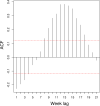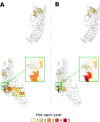Spatiotemporal dynamics of malaria in Zanzibar, 2015-2020
- PMID: 36639160
- PMCID: PMC9843203
- DOI: 10.1136/bmjgh-2022-009566
Spatiotemporal dynamics of malaria in Zanzibar, 2015-2020
Abstract
Background: Despite high coverage of malaria interventions, malaria elimination in Zanzibar remains elusive, with the annual number of cases increasing gradually over the last 3 years.
Objective: The aims of the study were to (1) assess the spatiotemporal dynamics of malaria in Zanzibar between 2015 and 2020 and (2) identify malaria hotspots that would allow Zanzibar to develop an epidemiological stratification for more effective and granular intervention targeting.
Methods: In this study, we analysed data routinely collected by Zanzibar's Malaria Case Notification (MCN) system. The system collects sociodemographic and epidemiological data from all malaria cases. Cases are passively detected at health facilities (ie, primary index cases) and through case follow-up and reactive case detection (ie, secondary cases). Analyses were performed to identify the spatial heterogeneity of case reporting at shehia (ward) level during transmission seasons.
Results: From 1 January 2015 to 30 April 2020, the MCN system reported 22 686 index cases. Number of cases reported showed a declining trends from 2015 to 2016, followed by an increase from 2017 to 2020. More than 40% of cases had a travel history outside Zanzibar in the month prior to testing positive for malaria. The proportion of followed up index cases was approximately 70% for all years. Out of 387 shehias, 79 (20.4%) were identified as malaria hotspots in any given year; these hotspots reported 52% of all index cases during the study period. Of the 79 hotspot shehias, 12 were hotspots in more than 4 years, that is, considered temporally stable, reporting 14.5% of all index cases.
Conclusions: Our findings confirm that the scale-up of malaria interventions has greatly reduced malaria transmission in Zanzibar since 2006. Analyses identified hotspots, some of which were stable across multiple years. Malaria efforts should progress from a universal intervention coverage approach to an approach that is more tailored to a select number of hotspot shehias.
Keywords: Epidemiology; Malaria; Public Health.
© Author(s) (or their employer(s)) 2023. Re-use permitted under CC BY-NC. No commercial re-use. See rights and permissions. Published by BMJ.
Conflict of interest statement
Competing interests: None declared.
Figures








References
-
- World Health Organization . World malaria report 2021. Geneva; 2021.
-
- ZAMEP . National malaria strategic plan. Stone Town, Zanzibar, 2020.
-
- ZAMEP . Annual Report 2019-2020. Stone Town, Zanzibar; 2021.
Publication types
MeSH terms
LinkOut - more resources
Full Text Sources
Medical
Miscellaneous
